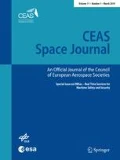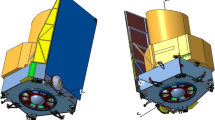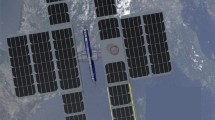Abstract
The ATHENA—Advanced Telescope for High-ENergy Astrophysics—mission is currently assessed in a phase A feasibility study as L-class mission in ESA’s Cosmic Vision 2015–2025 plan, with launch foreseen in 2028. Primary mission goal is the mapping of hot gas structures and the determination of their physical properties to search for supermassive black holes. ATHENA is an X-ray telescope with a focal length of 12 m. It has a mass of ~ 7000 kg and it is ~ 15 m high with a diameter of ~ 3 m. The main mass is distributed to the mirror on the one side of the spacecraft and to the science instrument module on the other side of the spacecraft. To achieve its science goals, ATHENA performs a sky survey with precision line-of-sight pointing requirements in the order of arc seconds for absolute pointing and sub-arc seconds for relative pointing in time windows > 1 ks, all at 95% confidence level. That is very demanding for large X-ray telescopes. In addition to the precision pointing requirements, ATHENA cannot violate a certain sun exclusion zone. This is a hard constraint to prevent any stray-light falling onto the instruments, as it would immediately destroy them. The sky survey is defined by an observation plan that is demanding in terms of availability and thus spacecraft agility. The pointing and agility requirements and the fact that ATHENA is a spacecraft with high mass and volume introduce several design challenges for the attitude and orbit control system. This paper presents those challenges, corresponding solutions, and preliminary results, which have been achieved during the phase A study led by Airbus in Friedrichshafen, Germany. The main focus and contribution of this paper are the identification of research and development needs for attitude and orbit control systems to enable the ATHENA mission. In this respect, the ATHENA design challenges are discussed and addressed with the state-of-the-art design methods. This paper concludes with the main identified technology development needs and formulates specific research questions related to practical design problems. In particular, the following attitude and orbit control system design challenges are addressed: autonomous and agile large angle slew manoeuvres with exclusion zones, availability for science observations, precision line-of-sight determination as well as analysis during the design process using the ESA Pointing Error Engineering Tool and pointing control with a hexapod as line-of-sight actuator in the control loop. The last challenge, namely, the hexapod in the control loop, is without precedence in Europe and to the best knowledge of the authors in the world.


















Similar content being viewed by others
References
ESA: ATHENA CDF Study Report: CDF-150(A), Tech. Rep., European Space Agency (2014)
Lumb, D.H., Schartel, N., Jansen, F.A.: X-ray Multi-mirror Mission (XMM-Newton) observatory. Opt. Eng. 51(1), 011009 (2012)
ESA Engineering Standardisation Board: Pointing Error Engineering Handbook ESSB-HB-E-003. In: ESA-ESTEC Requirements & Standards Division, 2011
ECSS—European Cooperation for Space Standardization: Control performance guidelines. In: ECSS-E-HB-60-10A, 2010
Doherty, K.M., Ghasemi-Nejhad, M.N.: Performance of an active composite strut for an intelligent composite modified stewart platform for thrust vector control. J. Intell. Mater. Syst. Struct. 16(4), 335–354 (2005)
Agrawal, B., Chen, H.-J.: Algorithms for active vibration isolation on spacecraft using a Stewart platform. Smart Mater. Struct. 13(4), 873–880 (2004)
Aridon, G., Al Majid, A., Blanchard, L., Remond, D., Dufour, R.: A self-deployment hexapod model for a space application. J. Comput. Nonlinear Dyn. 4(1), 1–7 (2009)
Aridon, G., Remond, D., Morestin, F., Blanchard, L., Dufour, R.: Self-deployment of a tape-spring hexapod: experimental and numerical investigation. J. Mech. Des. 131(2), 021003 (2009)
May, B.S., Jones, N.P.: Next generation space telescope. I: Design considerations. J. Aerosp. Eng. 7(4), 355–374 (1994)
May, B.S., Jones, N.P.: Next generation space telescope. II: Proposed pointing control system. J. Aerosp. Eng. 7(4), 375–397 (1994)
Hablani, H.B.: Attitude commands avoiding bright objects and maintaining communications with ground station. AIAA J. Guid. Control Dyn. 22(6), 759–767 (1999)
Bong, W.: Space vehicle dynamics and control, 2nd edn. https://doi.org/10.2514/4.860119
European Space Agency: Generic AOCS/GNC techniques and design framework for failure detection isolation and recovery. In: ESA ITT AO/1-7998/14/NL/MH, 12/06/2014
National Aeronautics and Space Administration: Fault Management Handbook—NASA-HDBK-1002, Washington DC, USA (2012)
Marcos, A., Deimos Space, S.L.: ADDSAFE: advanced fault diagnosis for sustainable flight guidance and control—final publishable summary report. In: EU FP7 program AAT-2008-RTD-233815, 25/12/2012
Zolghadri, A., Henry, D., Cieslak, J., Efimov, D., Goupil, P.: Model-based FDIR for space applications. In: Fault diagnosis and fault-tolerant control and guidance for aerospace vehicles: from theory to applications, pp. 151–207. Springer, Berlin (2014)
Day, J., Ingham, M.: Fault management at JPL; past, present and future. In: ESA ADCSS 2011 Workshop, 2011
Oganessian A.: FDIR engineering supported by ECSS. In: ESA ADCSS 2011 Workshop, 2011
Posch, A., Schwientek, A.O., Sommer, J., Fichter, W.: Model-based on-board realtime thruster fault monitoring. In: 19th IFAC Symposium on Automatic Control in Aerospace, Würzburg, 2013
Krysander, M.: Design and analysis of diagnostic systems utilizing structural methods. PhD Dissertation, Institutionen för systemteknik, Linköpings Universitet (2006)
Reggio, D.: Generic AOCS/GNC techniques & design framework for FDIR. In: 10th International ESA Conference on GNC Systems, Salzburg, Austria, June 2017
Hirth, M., Su, H., Ott, T., Casasco, M., Ortega, G.: PEET V1.0: the state-of-the-art pointing and performance error engineering tool for space missions. In: 10th International ESA Conference on GNC Systems, Salzburg, Austria, June 2017
Ott, T., Hirth, M., Casasco, M., Gedon, S., Ponche, A.: PointingSat—high precision pointing error analysis with ESA PEET v1.0. In: 10th International ESA Conference on GNC Systems, Salzburg, Austria, June 2017
Ott, T., Wiedermann, G., Crombez, V., Damilano, P.: Pointing budgeting using the ESA pointing error engineering handbook and tool: benefits and limitations. In: 9th International ESA Conference on GNC Systems, Oporto, Portugal, 2014
Graf, F., Ott, T., Lejault, J.P., Fichter, W.: Precision pointing estimator design for minimum absolute, window-and stability-time errors. IFAC Proc. Vol. 46(19), 224–229 (2013)
Acknowledgements
The results presented here have been partially achieved under the ESA phase A contract for the ATHENA mission study. The view expressed herein can in no way be taken to reflect the official opinion of the European Space Agency. In addition, some results used for this work are partially based on HOROES agil, which is a R&D activity financially supported by the Space Agency of the German Aerospace Centre (DLR, Deutsches Zentrum für Luft- und Raumfahrt e.V.) with means of the German Ministry of Economy and Technology under Support number 50 RR 1301. Herewith we thank the colleagues in the ATHENA study team and the DLR for supporting the publication of these results.
Author information
Authors and Affiliations
Corresponding author
Rights and permissions
About this article
Cite this article
Ott, T., Goerries, S., Schleicher, A. et al. AOCS design for the ATHENA X-ray telescope: challenges and solutions. CEAS Space J 10, 519–534 (2018). https://doi.org/10.1007/s12567-018-0213-9
Received:
Revised:
Accepted:
Published:
Issue Date:
DOI: https://doi.org/10.1007/s12567-018-0213-9




